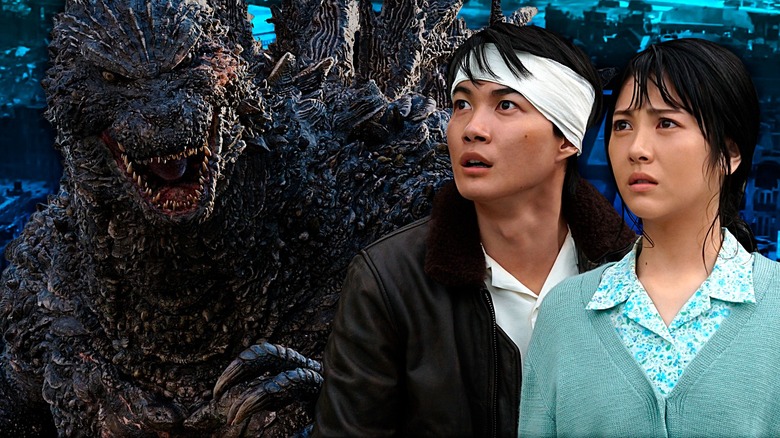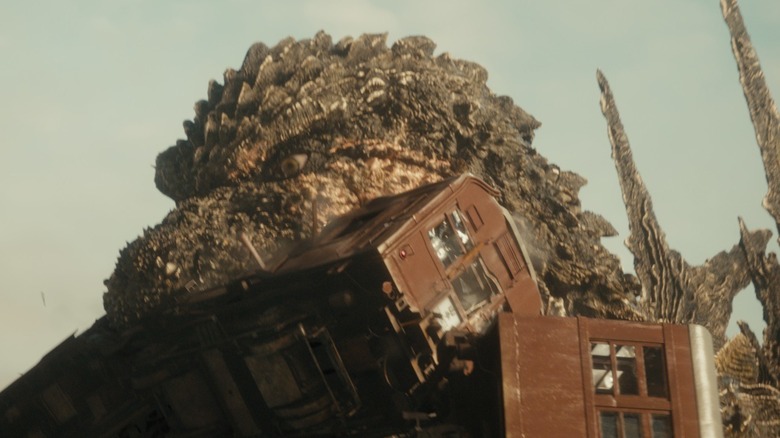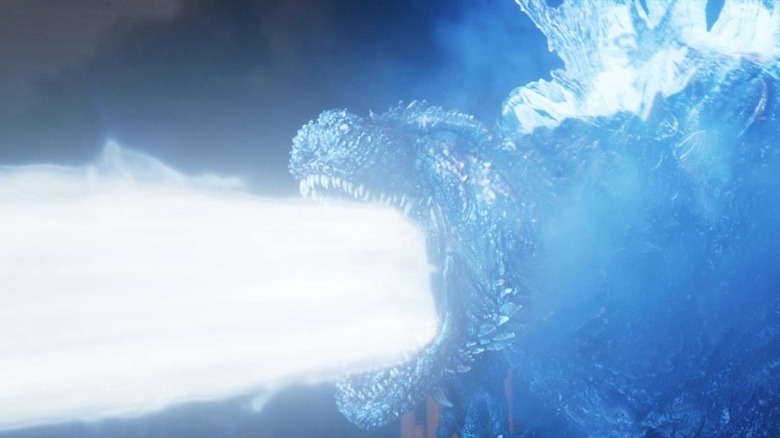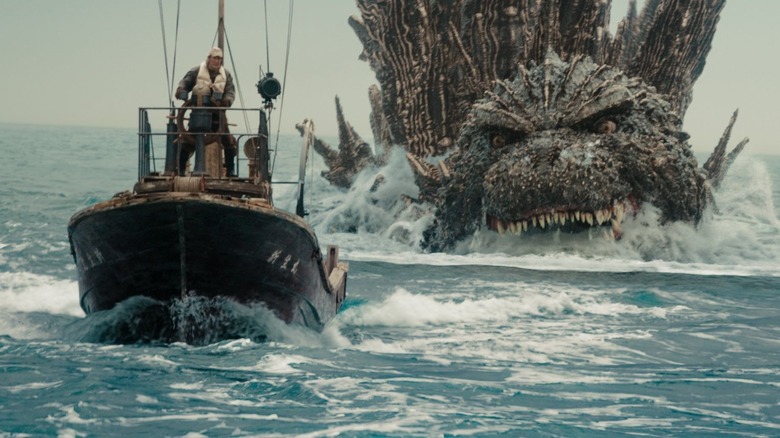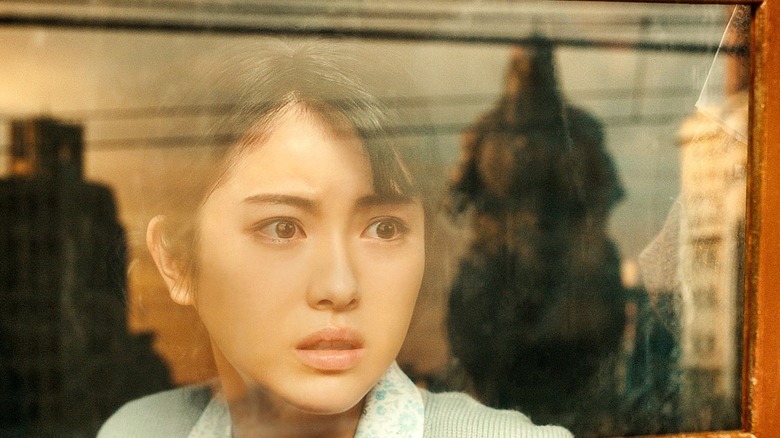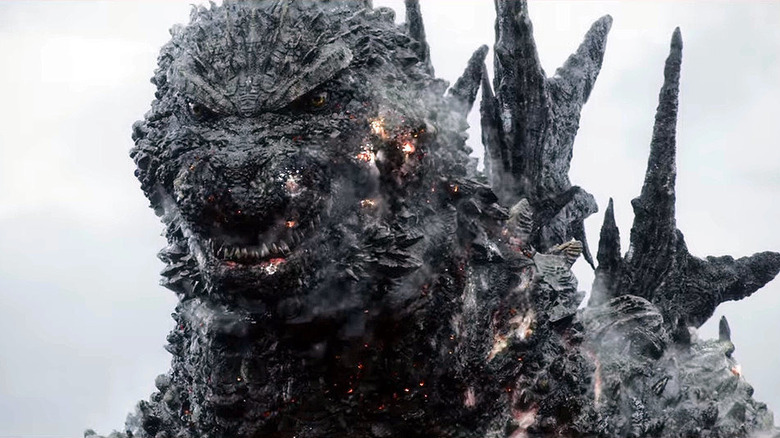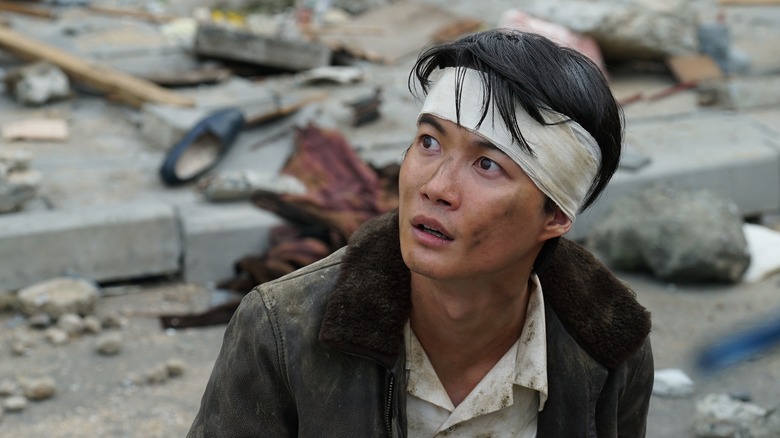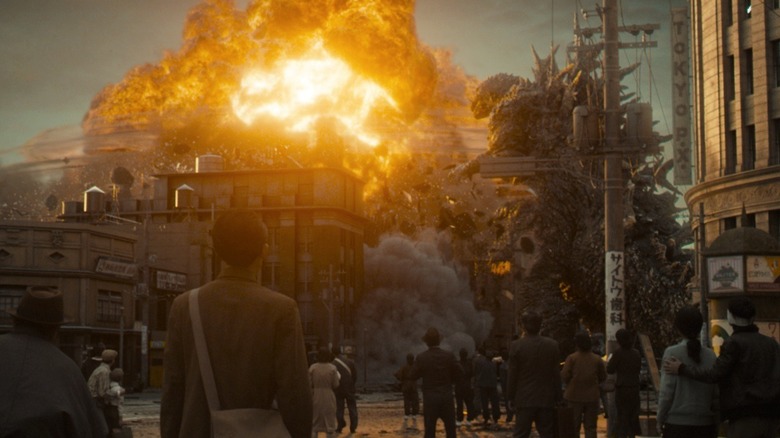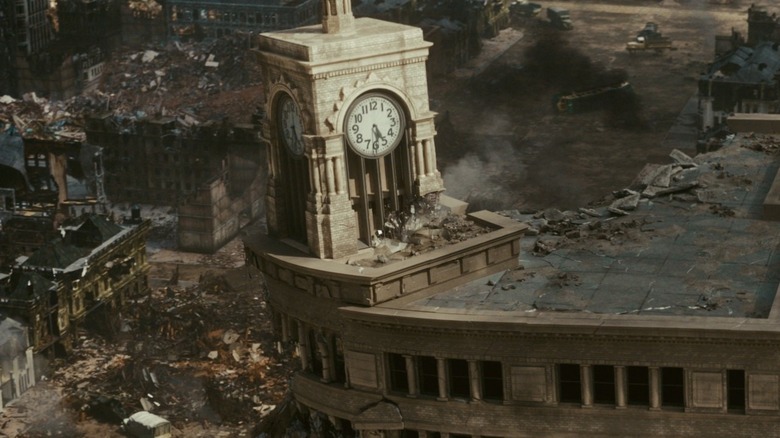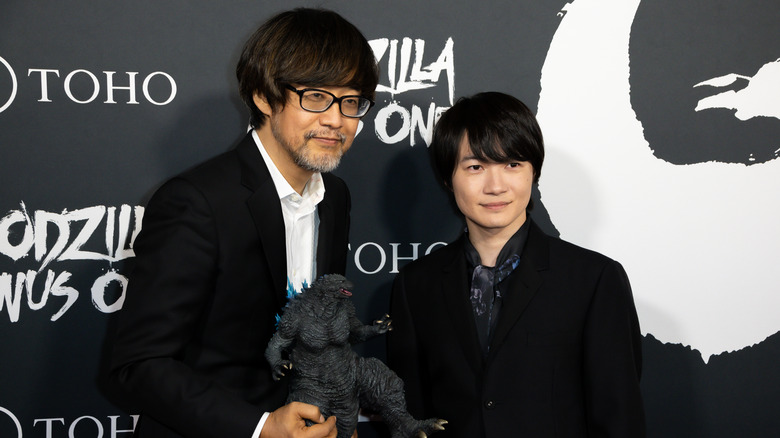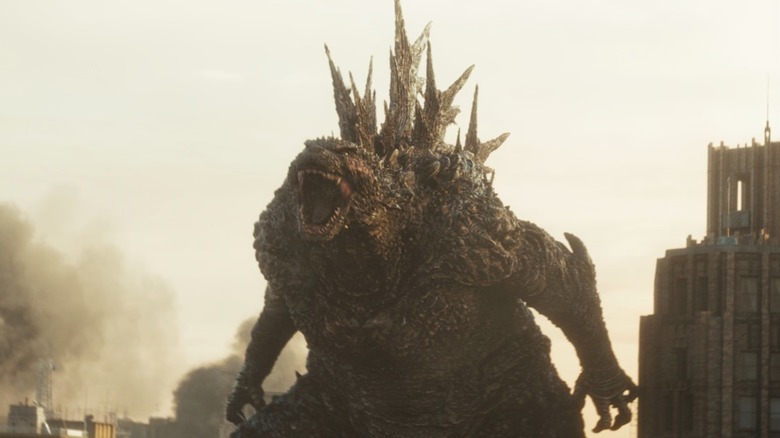The Ending Of Godzilla Minus One Explained
Contains spoilers for "Godzilla Minus One"
It seems only fitting that in the same year we got "Oppenheimer," we also got "Godzilla Minus One." And depending on who you ask, they might tell you that Toho's latest kaiju movie is actually head and shoulders above Christopher Nolan's nuclear epic. "Minus One" shows the carnage wrought on Japan not just by America's two nuclear attacks, but by the totality of World War II. It explores both the grief for all those who died in the violence and the emotional devastation felt by those who managed to survive. And it does it all while delivering one of the best Godzilla movies ever made.
Live-action Toho movies starring the King of the Monsters are a rare commodity these days. The modern Reiwa era of Godzilla films only has two, including "Minus One." But after 2016's "Shin Godzilla" got rave reviews, and now with the success of the latest installment, it looks like the franchise's Japanese arm could be entering a new golden age. Like its predecessor, "Minus One" swaps out the B-movie stylings of previous Godzilla eras for a more artistic cinematic approach. The shots are gorgeous. The score from Naoki Satō is beautiful. And alongside all that beauty, writer-director Takashi Yamazaki still manages to imbue the film with a powerful sense of dread.
In the end, though, the film finishes on an optimistic note — albeit one that leaves things open for a sequel. So let's dive deeper into the ending of "Godzilla Minus One" and what it all means.
What you need to remember about the plot of Godzilla Minus One
Like "Gojira," the original 1954 film, "Godzilla Minus One" is a war movie, even though it mostly takes place after the end of World War II. In the opening scene, we meet Koichi Shikishima (Ryunosuke Kamiki), a Japanese kamikaze pilot who abandons his squadron under false pretenses of mechanical trouble. He lands at the airbase on Odo Island, fearing that the other soldiers will condemn him as a coward. However, the commander of the base actually supports him, saying that it's foolish to die when Japan seems destined to lose the war.
That night, the entire base is wiped out by Godzilla — a prehistoric dinosaur of some kind known to the locals. Koichi has a chance to shoot the monster, but he panics, leaving him and mechanic Sosaku Tachibana (Munetaka Aoki) as the only survivors. Scorned by Tachibana for his cowardice, Koichi returns home after the war to find his Tokyo neighborhood decimated by American bombings. In the rubble, he meets Noriko (Minami Hamabe), a young woman caring for an orphaned baby named Akiko. The three form a kind of family, while Koichi gets a job dismantling mines off the coast of Japan.
In a montage, we see that Godzilla is mutated by the nuclear weapons tests at Bikini Atoll and begins attacking U.S. ships. He eventually reaches Japan, where he destroys more ships and lays waste to Tokyo's Ginza district, seemingly killing Noriko in the process. Devastated, Koichi joins a civilian effort to kill the beast, volunteering to serve as bait while flying an untested experimental aircraft from the war.
What happens at the end of Godzilla Minus One?
Because the Japanese military was disarmed following World War II, there's very little to stop Godzilla's rampage. In the absence of armed force, Dr. Kenji Noda (Hidetaka Yoshioka) devises a complex plan to defeat the beast. He intends to lure Godzilla out into a deep area of water, wrap him up in cables laced with Freon tanks, and use them to drop the monster 1,500 meters down. If the rapid change in pressure doesn't kill him, floatation devices will be deployed to bring Godzilla back up to the surface, wreaking havoc on his body.
As Noda helps organize a civilian navy (mostly consisting of former soldiers) to man the necessary ships, Koichi enlists Tachibana to modify his Shinden fighter plane. If all else fails, he plans to fly into Godzilla's jaws, hopefully destroying his brain and killing him with a mouthful of explosives. Koichi says that he intends to die if necessary to make things right, blaming himself for Godzilla's carnage, while Tachibana still seems to hold Koichi responsible for the Odo massacre.
The plan plays out smoothly, with Koichi in his plane leading Godzilla out to the target location. The Freon canisters fail to do the job, though, and the kaiju chews through the floatation devices at 800 meters when they pull him back up. All seems lost, but in the hour of despair, a whole fleet of tugboats arrives to help yank the monster to the surface.
The useless to the rescue
Dr. Noda, Yōji Akitsu (Kuranosuke Sasaki), and the other older men take the responsibility for the attack on Godzilla upon themselves. All survivors of the war, they see the beast as a remnant of that violence left unfinished. Though the young Shirō Mizushima (Yuki Yamada) wants to come with them, they order him to stay behind.
Of course, it's Shirō who leads the tugboat charge. The dedication of the former soldiers, while well placed, isn't enough to fully defeat Godzilla. It's no accident that they require assistance from "the useless," as Shirō calls them — those who never fought in the war — to literally pull them out. For Japan to move on and properly begin rebuilding, the movie seems to say, it will take a combined effort from the survivors and those who represent the future.
With Godzilla back on the surface of the water, Koichi takes his shot. Right as the kaiju is charging up his atomic heat ray, Koichi flies into Godzilla's mouth and detonates the payload, blowing up the monster's skull and causing his whole body to melt down and crumble. Koichi survives, having used the ejector seat to jump to safety. In a flashback, we see Tachibana encouraging him to survive the attack. "Live," he commands the pilot he despised for so long. And Koichi does.
Come back alive
In a happy twist, Koichi returns home to a telegram revealing that Noriko is actually still alive. The chaos in the Ginza attack left many victims injured and lost with no way to identify them. It seems that this fate also befell Noriko, who sustained wounds from Godzilla's heat ray blast but survived after being taken to a hospital. Koichi rushes to her bedside with Akiko in his arms, and the family is reunited. Noriko asks if Koichi's war is finally over, and he breaks down crying, clutching her to his body and declaring that yes, it finally is.
Of course, it isn't all sunshine and rainbows. As the happy reunion fades out, the camera shifts suspiciously to Noriko's neck, where the faintest sign of something dark can be seen undulating beneath the skin. This could simply be some kind of ordinary radiation poisoning — a scar from Godzilla's heat ray that may haunt her and her family in the future. But with Godzilla still being an unknown quantity in this incarnation, it could also be a sign of something more sinister. Perhaps Noriko was exposed to some kind of Godzilla DNA (or G-Cells, as they've often been called in previous movies). Such an infection might have even helped her survive her injuries. For now, though, there's too little evidence to say for certain what's happening to her.
Hopefully, the little family has weathered enough tragedies, and whatever's happening to Noriko can be remedied with further medical care. But when it comes to Godzilla, of course, the threat is never really gone.
Godzilla regenerates in the depths of the sea
The final shot at the end of "Godzilla Minus One" is an ominous one. After being shown whatever radiation sickness is festering inside Noriko, the camera jumps to the depths of the sea, where a mottled chunk of Godzilla's body begins to regenerate.
On its own, this shot doesn't necessarily mean that a sequel is coming. In fact, it's pretty common for Godzilla films to end with a promise of the monster's return. There will always be another Godzilla film, be it a direct sequel or yet another reboot, and one of the kaiju's defining traits is that he never stays down for long. Still, given the critical success of "Godzilla Minus One" and its widespread U.S. release, it could also become the first Toho entry in two decades to get a proper sequel.
Only time will tell, but at the very least, Godzilla's aquatic regeneration is a final note of dread on which to end the movie. The danger he poses — the shadow of nuclear weapons — remains, and it cannot be fully killed.
What the ending of Godzilla Minus One means
The dominant message of "Godzilla Minus One" is clear: Living is the real victory. Any supposed accomplishment that necessitates death — any great sacrifice in the name of fame, honor, or fortune — pales in comparison to the simple victory of living to build anew. For most of the movie, Koichi is wracked by guilt, calling himself "someone who wasn't supposed to live." He goes to great lengths to bring in Tachibana to fix the Shinden because he wants absolution. He wants to look the man who called him a coward in the eyes and declare that he is willing to die this time.
But when that moment comes, Tachibana tells him to live, the anger seeping out of him. After Koichi flies the Shinden into Godzilla, we see Tachibana listening at the radio with bated breath. Only when he hears that Koichi is still alive does he exhale, tears brimming in his eyes. His own war seems to have been ended by the act of forgiveness and the choice to live.
In fact, not a single human dies during the final attack against Godzilla. A decoy destroyer is blown up, but every other craft remains intact. "This time they'll make a difference," Yōji says as he watches the ex-soldiers prepare for the fight. "This time we're making it right." Unlike the war, he says, it's not a battle to the death. It's a battle for life, and for the future.
Godzilla as the shadow of war
In his best films, Godzilla has always been a symbol — most frequently a walking embodiment of the destructive power of nuclear weapons, or an avatar for the punishment Japan received after World War II. That's certainly part of his characterization in "Minus One," but the film makes the King of the Monsters more complicated than that. "Godzilla is more of an undiscerning god," writer-director Takashi Yamazaki recently told Vulture. "In Japan, it's integrated into Shinto belief. All of these negative things in the world have manifested themselves into Godzilla. And, us as humans, we're not out to kill Godzilla, but we're able to calm Godzilla and bring ourselves back to peace."
The kaiju is arguably at his most terrifying ever in "Minus One," with a heat ray that detonates like a nuclear warhead and a roar that follows every brutal attack. Godzilla doesn't just seem angry at humanity; he seems angry at simply being alive. It's a rage that reflects Koichi's own survivor's guilt — a feeling of discomfort with the gift of life.
It's not just the atomic bomb that has summoned the monster in this version of the story, but the combined grief, anger, violence, and shame that those who escaped the war are left with. Defeating Godzilla means putting those things to rest and finally choosing to live for the future. That's why the former soldiers need the younger generation to help them win in the end, and it's the reason that true victory for Koichi means surviving his final attack.
Power to the people
One of the recurring themes throughout "Godzilla Minus One" is disillusionment with the Japanese government in the wake of World War II. Yōji Akitsu acts as the main mouthpiece for these criticisms, frequently condemning the government's censoring of information and overall corruption. It's clear that he blames Japan's leadership for getting the country into a bloody war it was never going to win. For Yōji, the grief felt by all of his friends is all the fault of a failed administration.
Of course, "Minus One" also comments on the fragile state Japan was thrown into by the United States after the war. "Minus One" shows just how powerless the nation is to defend itself because of its military disarmament. Even the battleship that faces Godzilla halfway through the movie is about to be scuttled. Had Godzilla not begun his reign of terror by attacking American ships, it's doubtful that Japan would be given any resources with which to fight him.
In the end, it's the combined strength and determination of the Japanese people that defeats the monster at their door. Yamazaki makes a point of showing that no one is coerced or conscripted into joining the fight this time. The group rises up of its own accord out of a desire to defend their home, not through a command from on high to die in the name of conquest. This sense of unity is what ultimately brings victory, both against Godzilla and in the effort to rebuild.
Found family and reconstruction
The emotional core of "Godzilla Minus One" is the unique family dynamic between Koichi, Noriko, and Akiko. They first meet by sheer happenstance, and Koichi quickly learns that Akiko isn't even Noriko's baby — just the child of a dying woman who asked Noriko to take care of her. Then Sumiko Ōta (Sakura Ando) jumps in as a sort of surrogate aunt or grandmother. It's a family that would have never formed had any of the adults simply chosen to act selfishly, but the result is a happy, stable home, albeit one still haunted by Koichi's lingering trauma.
By the end of "Godzilla Minus One," Koichi finally puts those demons to rest. This strange foursome, none from the same family originally, seems indicative of the larger reconstruction movement shown throughout the film. Pretty much everyone we meet in the movie lost someone in the war. In the cases of Noriko, Koichi, and Sumiko, they lost their whole families. And yet, faced with what feels like insurmountable grief, they build a new community and push forward.
In a mid-movie montage, we see the bombed-out house where Koichi's family once lived slowly rebuilt, turning once again into a place where happy memories can be made. He invites his work colleagues over for dinner, and they comment on what a lovely home it is, all knowing full well what the neighborhood used to look like. It's this defiance in the face of devastation — this passion for a better future — that helps these characters make it through.
What has the cast and crew of Godzilla Minus One said about the ending?
Takashi Yamazaki has spoken extensively about his goals for "Godzilla Minus One" and the films that inspired it. "Sometimes the story is told where you switch to Godzilla and then you switch to the human story, and they end up kind of existing independently," the writer-director told Moviefone regarding past Godzilla films. "But I really wanted to make sure that they were intertwined in a balanced way so that the human drama and whatever's going on with Godzilla had the right balance."
Asked about the lasting impact of Godzilla, Yamazaki explained his perspective on what the creature represents culturally. "It's the concept of an animal or object absorbing so much evil energy, or the negativity of the world, that it takes shape," Yamazaki told Moviefone. "This needs a cycle every couple of decades. I think maybe it's just the timing that we need to be reminded and go through the exercise of visualizing your worries, evils and whatever's going on in the world ... and going through this process of calming those negative energies in the form of Godzilla."
In the same interview, star Ryunosuke Kamiki discussed where his character, Koichi, winds up by the end of the film. "I feel that before Shikishima meets Noriko and Akiko, that he's questioning himself, 'Should I live, do I even deserve to live?'" the actor said. "Noriko and Akiko create a place for Shikishima to be and to exist."
What does the ending of Godzilla Minus One mean for the franchise?
The ending of "Godzilla Minus One" practically begs for a sequel. Noriko's story seems to be complicated by her strange radiation sickness, and Godzilla is regrouping at the bottom of the sea. With all the praise that the human characters in the movie have gotten from critics and viewers, it would be great to see the cast return for a follow-up. But how likely is that?
Toho hasn't made a proper live-action sequel to a Godzilla movie since 2003, when "Godzilla: Tokyo S.O.S." followed up the story of the previous year's "Godzilla Against Mechagodzilla." Only three live-action Godzilla films have been released by Toho since then: 2004's "Godzilla: Final Wars," 2016's "Shin Godzilla," and "Minus One." Each of those projects acts as an independent story, with no shared continuity between them.
In short, Toho has been stingier than ever over the last two decades when it comes to the King of the Monsters. That makes the chances of a "Minus One" sequel look slim, but there is hope. Thanks in part to the success of Legendary's MonsterVerse films, Godzilla has had somewhat of an international resurgence. And with "Minus One" receiving a wide release in North America, Toho could be testing the waters for more frequent productions going forward. That's all up in the air for now, but even if no sequel arrives, "Godzilla Minus One" has gifted fans with one of the greatest kaiju movies ever, and one of the best films of 2023.
